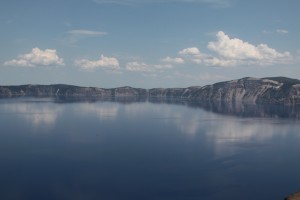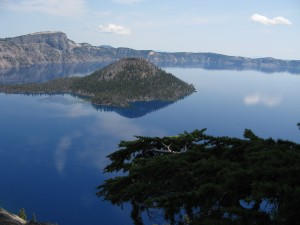The Park
Mt. Mazama used to be a lovely, snow-capped, 12,000 foot volcano. Then, 7,700 years ago, it’s magma chamber rose to the surface and it erupted. The eruption was 100 times stronger than Mt. St. Helens. After the eruption, with the center of the volcano gone, the sides of the mountain collapsed, forming a caldera. Over time, the caldera filled with rainwater and snow forming Crater Lake. Crater Lake is exceptionally deep at 1,943 and exquisitely blue. A small cinder cone island, called Wizard Island, sits on one side of the lake.

My Experience
It’s easy to escape the hordes of people by taking a hike. From the main parking lot at Rim Village, I took a trail that meanders along the left side of the crater. At over 6,000 feet, the landscape is dry, sandy and sparse. Gnarled
whitebark pine trees grow along the crater’s ridge. Lupine and a few other wildflowers add some color to the white sandy soil. I slowly walked along enjoying the vivid blue sky, the unique plant life and the frequent overlooks of Crater Lake and Wizard Island. I eventually came to small snow patches. Cars drove along the park road in the near distance. I had the views, flowers and trees to myself. Not a soul was on the trail.
Empty coffee cup in hand, I returned to the parking lot, pulled out my lounge chair, ate lunch, snoozed under a tree and then went to a ranger talk. It was our ranger’s first day giving his talk. He was geologist and told us details about the blast that formed the crater. I learned that Mt. Mazama was originally made up of all four types of volcanoes: strato, shield, dome and cinder cone. Each type of volcano erupts in a way that can be demonstrated with common grocery store products. Strato volcanoes are like Squirt, they fizz and release gas. This sends rocks down the sides of the volcano. Shield volcanoes are like maple syrup, basalt oozes down the sides. Dome volcanoes are like toothpaste. They have a thick mass coming down their sides. And cinder cones are like popcorn. I guess they suddenly pop up.
After the ranger talk I went away from the crater rim to the Castle Creek Meadow trail that was build by the Civilian Conservation Corps. I figured that if the CCC built a wildflower trail, it must be good. The informational pamphlet at the beginning of the trail gave nice information on the trees I’d be seeing: Shasta Red Fir, Mountain Hemlock, Lodgepole Pine and Subalpine Fir. The tree that stood out to me was the Shasta Red Fir. When you look up at its branches, they make a snowflake pattern. On this trail I didn’t see why they were called red firs, but later on, in Yosemite, I would come across a mature stand of them glowing reddish-orange in the sunlight. The wildflower trail looped up one side of a stream, crossed it, and went back down the other side. The only thing out in the meadow in early July were mosquitoes. I did see a few shooting stars as I hurried along the trail trying to stay ahead of the swarm that was following me. I wonder what the meadow looks like at the height of the wildflower bloom, and if one is able to enjoy the flowers without being inside a full mosquito net.
I did the drive around the crater but didn’t find it as interesting as taking the hike along the rim where I could stop, observe and ponder the all that was around me. Jack London, who saw a lot of the world, was awed by Crater Lake.
I thought that I had gazed upon everything beautiful in nature as I have spent many years traveling thousands of miles to view the beauty spots of the earth, but I have reached the climax. Never again can I gaze upon the beauty spots of the earth and enjoy them as being the finest things I have ever seen. Crater Lake is far above them all. Jack London 1911


